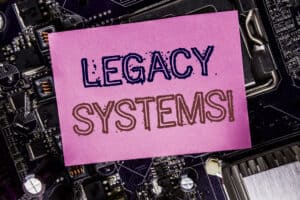
Legacy systems are at the center of business operations. So, you can’t use AI to understand or improve your business operations without them.
If you were to make a list of the trendiest types of technologies today, there’s a good chance that artificial intelligence would be right at the top. Legacy systems and application platforms, however, would probably feature much lower.
That doesn’t mean that AI and legacy apps are worlds apart. On the contrary, businesses that run legacy apps – which are in use within more than two-thirds of organizations today – should incorporate such applications into their AI strategies. Doing so is the only way to ensure that future AI solutions deliver value to the business.
What should enterprises be doing today to leverage legacy systems when seeking AI-powered business insights? The Cloud is the answer.
How legacy systems help enable AI
The main reason why legacy applications are so important to enterprise AI strategies is simple: AI tools are only as good as the data pools. Much of the core business data that companies depend on is housed in legacy systems.
Enterprise Resource Planning apps (ERP) software is a prime example. ERP applications are responsible for helping to manage critical business functions, like finance and inventory management. If you want to use AI tools to unlock insights into core business practices and identify future opportunities, those legacy data collections will be needed to feed AI tools for results.
One example reflecting the value of legacy system data involves a global beverage company revisiting historic data compiled from its manufacturing operations. By connecting their data to an AI tool that cross-referenced their data models with third-party weather bureau sources, the business discovered a surprising and important trend: The effectiveness of their manufacturing operations varied depending on weather conditions. Using this blended information, the business optimized its manufacturing to save on cost and delivery during various types of weather.
Data from modern apps that are not hosted on legacy platforms might also be useful for gaining insights into customer relations management or sales processes. However, if you want AI to effectively optimize the processes at the very center of your business, you will probably need to pull data from legacy applications for successful forecasting.
Legacy apps are AI-friendly
It’s worth noting that there’s no reason why modern AI solutions can’t work just as well with legacy data as they can using data pools. Even if your legacy apps were created decades ago, it’s likely that they store data using the same foundational technologies (like relational databases) as modern applications. That means you can export data from the apps and use it to power AI tools just as you would with modern apps.
Without utilizing the best tools for migration and integration, utilizing legacy data can run into problems. Legacy systems may format data in unusual ways, for instance, requiring data conversion in order to make the information available to AI tools. However, these aren’t show-stopper issues. Nor are the challenges unique to legacy systems; any application could manage data in non-standardized ways that businesses must address before they can use the data to help drive AI tools.
The bottom line is that legacy systems are capable of producing the data that modern AI solutions need to do their jobs.
See also: Why the Mainframe is the Opposite of Legacy Tech
Getting started with AI for legacy systems
There are a variety of AI tools out there that businesses can use to analyze their processes and operations. Some, like predictive analytics solutions, have been around for years. Others, especially those that leverage generative AI technologies, are still emerging. No matter which type of AI tool you want to use to gain business insights from legacy systems, the process for doing so is simple enough.
Move legacy apps to the cloud
Where possible, move your legacy systems to a hyperscale cloud platform. While you don’t strictly need to do this to feed your legacy system data into AI tools, hosting the apps in the cloud makes the process easier because the apps are more scalable. It’s also easier to monitor them in a centralized way when they are consolidated into a cloud platform.
Connect legacy apps to AI tools or services
Next, connect your legacy apps to the AI tools or services you want to use to analyze your processes. This may involve exporting data from the apps, but in some cases, AI tools are able to integrate with legacy apps or databases directly.
Secure your data
There are noteworthy security and privacy risks associated with the fast-evolving world of AI tools. Remember, you want to make sure that any third-party AI solutions that consume sensitive business data will not place such information in jeopardy of public exposure. Solutions like Azure OpenAI, which is powered by the same technology behind ChatGPT but gives companies more control over how their data is used, are helpful for this purpose: protecting your sensitive information.
Analyze and validate results
As AI solutions begin to deliver insights into your business processes, decide which insights are most valuable to your organization and decide how to act on these insights.
Further, always validate any recommendations made by AI tools. Generative AI solutions have become infamous for their tendency to “hallucinate,” which means they invent suggestions or results that are not valid. This doesn’t mean that AI-powered insights are not valuable – they are, as long as the rate at which AI tools deliver inaccurate information is lower than the rate at which humans do the same – but it does mean you’ll want to review AI-powered recommendations critically before acting on them.
Conclusion
To be clear, I’m not suggesting that simply connecting legacy systems to AI tools will solve every business challenge under the sun. There are limitations to what you can achieve with AI, just as there are limitations to the effectiveness of any technology. I do believe that most businesses will find AI-powered insights to be much richer and more comprehensive when those insights are founded, in part, on historic data from legacy systems. Legacy systems are at the very center of business operations, and you can’t use AI to understand or improve your business operations very effectively if you skip legacy systems when planning your enterprise AI strategy.






























